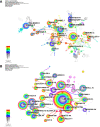Research trends and prospects on brain metastasis from breast cancer: A bibliometric analysis
- PMID: 37091185
- PMCID: PMC10113486
- DOI: 10.3389/fonc.2023.1091249
Research trends and prospects on brain metastasis from breast cancer: A bibliometric analysis
Abstract
Introduction: Brain metastasis is the terminal event of breast cancer with poor prognoses. Therefore, this article aimed to provide an updated summary on the development, hotspots, and research trends of brain metastasis from breast cancer based on bibliometric analysis.
Method: Publications on breast cancer with brain metastasis retrieved from the Web of Science Core Collection. CiteSpace, VOSviewer, and other online bibliometric analysis platforms were used to analyze and visualize the result.
Result: In totality, 693 researchers from 3,623 institutions across 74 counties and regions published a total of 2,790 papers in 607 journals. There was a noticeable increase in publications in 2006. The United States was the dominant country with the most publications followed by China. University Texas MD Anderson Cancer Center was the most productive institution, while Dana Farber Cancer Institution was the most cited. Journal of Neuro-Oncology published the most papers, while Journal of Clinical Oncology ranked first based on cocited analysis. Nancy U. Lin was the most productive and cited author with high influence. There was a focus on basic research, clinical trials, local therapy, treatment optimization, and epidemiological studies regarding brain metastases from breast cancer. References focused on pathogenesis, prevention, treatment, and prognosis were cited most frequently, among which the clinical trial of novel treatment attracted most attention from researchers. Reference citation burst detection suggested that new therapies such as the novel tyrosine kinase inhibitor and antibody-drug conjugate may lead the research trends in the future.
Conclusion: High-income countries contributed more to the field of breast cancer with brain metastasis, while developing countries like China developed quickly. Furthermore, the success of novel therapies in recent years may lead to the new era of treatment of breast cancer with brain metastasis in the future.
Keywords: ADC (antibody-drug conjugate); TKI (tyrosine kinase inhibitor); bibliometric analysis; brain metastasis; breast cancer; research trend.
Copyright © 2023 Wu, Liu, Zhou, You, Zhou, Chen, Kwan, Zhao, Wu and Liu.
Conflict of interest statement
The authors declare that the research was conducted in the absence of any commercial or financial relationships that could be construed as a potential conflict of interest.
Figures









Similar articles
-
A bibliometric and visualization analysis of research trends and hotspots on targeted therapy for breast cancer from 2003 to 2022.Front Oncol. 2024 Jun 4;14:1366900. doi: 10.3389/fonc.2024.1366900. eCollection 2024. Front Oncol. 2024. PMID: 38894873 Free PMC article.
-
The evolution of minimal residual disease: key insights based on a bibliometric visualization analysis from 2002 to 2022.Front Oncol. 2023 Jul 18;13:1186198. doi: 10.3389/fonc.2023.1186198. eCollection 2023. Front Oncol. 2023. PMID: 37534257 Free PMC article.
-
Trends in Breast Augmentation Research: A Bibliometric Analysis.Aesthetic Plast Surg. 2022 Dec;46(6):2691-2711. doi: 10.1007/s00266-022-02904-9. Epub 2022 Jun 2. Aesthetic Plast Surg. 2022. PMID: 35654858 Free PMC article.
-
Characterization of global research trends and prospects on platinum-resistant ovarian cancer: a bibliometric analysis.Front Oncol. 2023 Jun 5;13:1151871. doi: 10.3389/fonc.2023.1151871. eCollection 2023. Front Oncol. 2023. PMID: 37342181 Free PMC article. Review.
-
A bibliometric study and visualization analysis of ferroptosis-inducing cancer therapy.Heliyon. 2023 Sep 9;9(9):e19801. doi: 10.1016/j.heliyon.2023.e19801. eCollection 2023 Sep. Heliyon. 2023. PMID: 37809417 Free PMC article.
Cited by
-
A global bibliometric and visualized analysis of the status and trends of lung metastasis in breast cancer research from 2000 to 2024.Discov Oncol. 2025 May 8;16(1):700. doi: 10.1007/s12672-025-02496-1. Discov Oncol. 2025. PMID: 40341427 Free PMC article.
-
Antibody-drug conjugates for breast cancer: a bibliometric study and clinical trial analysis.Discov Oncol. 2024 Aug 2;15(1):329. doi: 10.1007/s12672-024-01192-w. Discov Oncol. 2024. PMID: 39093344 Free PMC article.
References
-
- Persson E, Gregersson P, Gustafsson A, Fitzpatrick P, Rhost S, A. Stahlberg and G. Landberg: Patient-derived scaffolds influence secretion profiles in cancer cells mirroring clinical features and breast cancer subtypes. Cell Commun Signal (2021) 19(1):66. doi: 10.1186/s12964-021-00746-7 - DOI - PMC - PubMed
LinkOut - more resources
Full Text Sources
Miscellaneous

